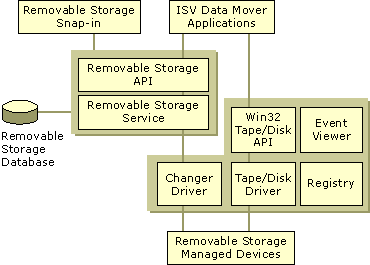Removable Storage Service
Using low-level services provided with Windows 2000, Removable Storage acts on requests made by client applications, including:
- Mounting and dismounting media
- Cleaning drives
- Adding and removing media
- Library inventory
- Enabling and disabling libraries, drives, and media
- Accessing media and library attributes
Removable Storage provides these services to client applications by means of an API. This API, and the services provided through it, hide the details of the various drives and libraries. Removable Storage implements a generic changer model which incorporates all essential aspects of libraries and drives. Removable Storage drivers map real drives and changers to this model.
Moving media within a robotic-based library is one example of how Removable Storage is used. The media-moving hardware (usually referred to as a transport) on the hundreds of robotic libraries available today varies widely. Some robotic libraries have hands that grab media and move them from a home storage location (usually referred to as a slot) to a drive. Other types of robotic libraries move a magazine containing some number of media and then push one medium from the magazine into a drive. A mount request from a Removable Storage application mounts media of either description. Figure 2.3 shows the Removable Storage components.

Enlarge figure
Figure 2.3 Removable Storage Components
© 1985-2000 Microsoft Corporation. All rights reserved.
EAN: N/A
Pages: 404